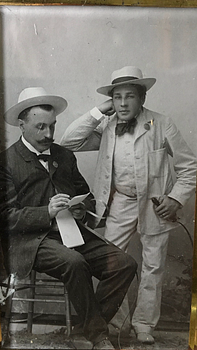Carl Bergsten
An armchair, by Gemla Leksaksfabrik Diö, for the exhibition in Norrköping Sweden 1906.
Black stained wood, plugged joints, spherical wooden feet, seat and back covered in green leather, height 88 cm, width 92,3 cm, seat height 36 cm.
Carefully restored, leather not original, wear.
Alkuperä - Provenienssi
Contractor Ernst Lundberg (1878-1946). Wedding present from Carl Bergsten in 1906. Thence by descent.
Näyttelyt
The model exhibited at the "Industriutställningen" in Norrköping, Sweden 1906.
Kirjallisuus
Teknisk tidskrift, organ för Svenska teknologföreningens afdelning för husbyggnadskonst Arkitektur och dekorativ konst, STF, Stockholm, 1908, 6/6 p. 68-69.
Festin, Bonnie, Carl Bergsten: en arkitekt och hans former, Norrköpings stadsmuseum i samarbete med Jernhammar & Co reklambyrå, Norrköping, 2005, p. 79.
Nielsen, Marianne, Lillan: minnen från ett skådespelarliv, Alter, Stockholm, 1987.
Muut tiedot
The chairs were designed for Strömsholmens Café at the Industrial Exhibition in Norrköping in 1906. These armchairs were a wedding gift from Carl Bergsten to his close friend and colleague Contractor Ernst Lundberg.
Architect and furniture designer Carl Bergsten's significance for the development of modern architecture and furniture design in Sweden during the beginning of the 20th century cannot be overestimated. Several of his assignments, such as the Industrial Exhibition in Norrköping in 1906, the Swedish pavilion at the World Exhibition in Paris in 1925 and the interior of the MS Kungsholmen in 1928, have been of crucial importance for the development of Swedish architecture and design.
Carl Bergsten (1879-1935), then 25 years old, was appointed Chief Architect at the Industrial Exhibition in his hometown of Norrköping in 1906. During an earlier study trip to Europe, Bergsten met architect Josef Hoffmann in Vienna and became inspired by him and his colleagues active in the progressive Viennese Secession. Bergsten took the impressions home to Sweden and in 1906 he carried out one of the largest modern manifestations in Swedish history. For Strömsholmens Café and Restaurant, Bergsten designed, among other things, a chair and an armchair which, with its austere geometric shapes and technical innovations, came to write Swedish furniture history. The armchair, which according to pictures from the exhibition was only made in a few copies, is extremely unusual. To our knowledge, in modern times it has never appeared on the market but only appeared in public at Norrköping City Museum. The majority of the chairs were probably destroyed in a fire in the 1930s. The exhibition building was later demolished in the 1940s. These two exclusive armchairs are probably Bergsten's first executed copies as they both differ in design, with odd manufacturing details and material choices.
Bergsten's innovative design required its manufacturer, which Bergsten found with Gemla Leksaksfabrik in Diö. The then-new bentwood technology that inspired him during the meeting with Josef Hoffmann in Vienna required an ambitious producer. Together with Gemla, they experimented with materials and techniques to produce the first bentwood furniture in Sweden, the auction's two armchairs.
Contractor Ernst Lundberg (1878-1946) was born in Strömsbro in Gävle. After graduating as a civil engineer in Stockholm, Lundberg quickly became successful for his enormous professional knowledge and his happy mood. The industrial exhibition in Norrköping in 1906 was one of his first major projects and was the starting point of a long and close friendship with Carl Bergsten. Ernst Lundberg married Astrid Lundberg in 1906. Carl Bergsten's wedding gift, the two armchairs, has followed the family ever since. Ernst Lundberg collaborated with several architects during his career and became a successful developer.






































































































